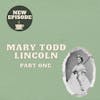Mary Todd Lincoln: Part One

The wife of 16th President Abraham Lincoln, Mary Todd Lincoln is generally known for her eccentric personality. However, there is so much more sitting beneath the surface.
Join me this week as I begin the life and times of Mary Todd Lincoln.
Welcome to Civics and Coffee. My name is Alycia and I am a self-professed history nerd. Each week, I am going to chat about a topic on U.S history and give you both the highlights and occasionally break down some of the complexities in history; and share stories you may not remember learning in high school. All in the time it takes to enjoy a cup of coffee.
INTRO MUSIC
Hey everyone, welcome back.
A domestic conflict that saw families and neighbors torn apart, the Civil War inflicted immense pain on thousands of Americans. Many across the country dealt with the internal war of trying to keep their close friendships or families together while also dealing with the external impacts of war on their communities.
This inner turmoil was perhaps no better exemplified than through the life of First Lady Mary Todd Lincoln. A woman with southern roots who was deeply committed to her husband, Mary Lincoln faced tremendous hardships in service of her country.
Mary and Abraham Lincoln are one of the most studied presidential couples in American history. There have been dozens of books written about their relationship, analyzing their affections from every possible angle. The intense focus on their marriage reminds me of the investigations into John and Abigail Adams or Franklin and Eleanor Roosevelt. As the first First Lady to become a widow due to an assassin's bullet, it makes sense there would be such fascination with Mary and how she pulled through her grief in the aftermath of her husband’s violent death.
She is perhaps best known today for some of her eccentric qualities, such as her dalliances with mediums in the midst of her intense grief after losing her sons and husband. But there is more beneath the surface. In fact, like her husband, I felt that there was no way I could do her life - and her significant loss - justice in a single episode. Therefore, Mary Lincoln will become just the second first lady covered that requires two episodes.
So this week, I am diving into the early life of Mary Todd Lincoln. Who was she? How did she meet the future president? And what role did she play in his political aspirations?
Grab your cup of coffee, peeps. Let’s do this.
Entering the world on December 13, 1818 in Lexington Kentucky, Mary Ann Todd was the fourth child born to her mother, Eliza, and her banker father Robert Smith Todd. Her father had a military background and was a local politician and Mary enjoyed the benefits of being born into a well to do Southern aristocratic family. Mary lost her mother when she was just six years old, when Eliza died after giving birth to her seventh child.
Losing her mother at such a young age likely left a mark on Mary, who spent the rest of her life vying for the love and attention of her father. Her push for attention only became more pronounced and difficult when Todd remarried just two years later and had another nine children with his young bride Betsy. Whether due to a clash of personalities or Mary’s immense pain from losing her mother at such a young age, the young Todd did not get along with her new stepmother. The number of children made the Todd living situation a bit tight, but Robert did what he could to make sure his family was provided for.
This included education. Mary was very well educated for the time period and well even better educated than some of the men, attending an all girls school where she learned French and of course the necessary qualifications to be a suitable wife and mother. Her strong education likely fueled her sense of confidence and Mary had no qualms about engaging in conversations typically relegated to men only, including frequent house guest Henry Clay. From historian Catherine Clinton, quote: “her ability to insert herself into powerful circles of political men came from early practice,” end quote. Mary was very sure of herself and her place in society and was unafraid to express herself. However, this was a time when women, and especially young ladies, were expected to be seen and not heard. This meant that Mary had a reputation as being a bit tempestuous, even in her youth.
Living in the south also meant Mary had early and extensive exposure to the slave economy. As a prominent southern gentleman, Robert Todd claimed ownership of several Black men and women whose unpaid labor made it possible for the household to function. Given the fact that between his two wives, Robert Todd had sixteen children to care for, Mary and her siblings were frequently under the care of a Black enslaved woman. For her part, Mary’s views on slavery remain a bit ambiguous. While it appears she recognized the inhumanity of the practice, she did not necessarily believe the races were equal.
Dealing with an increasingly overcrowded family home, Mary decided to visit her sister Elizabeth in Springfield, Illinois. This visit would forever alter Mary’s life as it brought her into future president Abraham Lincoln’s orbit. Lincoln, working to put together his political career, was likely making house calls when he first encountered the young Mary. At the time of their initial meeting, Lincoln had not yet reached the pinnacle of his professional life. He carried with him a series of debts and was striving to make a name for himself in politics. He was not of the same social or economic station as Mary, which would make a match with her, the very picture of a southern belle, unlikely. In fact, Lincoln rival Stephen Douglas apparently sought to court Mary, but did not get very far. Abraham and Mary were fated and connected over their shared love of politics and poetry. After their first meeting in 1840, the two put a pause to their courtship. It is not known exactly what transpired to create a rift, but just two years later Mary and Abraham were back on and finally married in her sister’s parlor on November 4, 1842.
Marrying a rising politician created a bit of a learning curve for Mary. A woman who was born into wealth and status, the new Mrs. Lincoln had to learn to economize and make the most of the limited income her husband was able to bring in. Their first few years required a bit of an adjustment for Mary, as the couple lived in boarding houses even as they welcomed their first child, Robert Todd Lincoln, who was born on August 1st, 1843. The young wife and mother also had to contend with extended absences, as her husband traveled as a circuit lawyer. Loneliness was something Mary never handled very well and these periods without her husband were yet another challenge for her to navigate.
Lincoln’s time as a lawyer proved profitable and the couple were soon able to move from boarding houses to their own estate. Purchased in 1844, the home still exists today as a National Historic Site and remains the first and only home owned by the future president. The home proved helpful to Mary as she oversaw the expansion of their family. The Lincolns added to their household as Mary gave birth again in 1846, another son by the name of Edward Baker Lincoln. However, young Edward would not live to adulthood, passing away as a toddler in 1850 from consumption, otherwise known as tuberculosis.
A woman who felt deeply, Mary was understandably devastated by the loss of her son. While infant mortality was still a common issue in the mid-nineteenth century, that proved to be of little comfort for the mothers and fathers who bore the brunt of the grief of outliving their children. For Mary, the loss brought on a deep depression and it would be a condition she struggled with throughout her life as she went through grief over and over again, eventually losing three of her four sons. Not to mention the immeasurable pain she’d experience witnessing the violent attack on her husband. Despite what must have felt like overwhelming grief, the Lincolns worked to move past their sorrow, welcoming their third son, William Wallace Lincoln, on December 21, 1850.
Perhaps another thing that kept Mary afloat was her deep belief in the potential of her husband. She apparently once said quote: “He is to be President of the United States some day; if I had not thought so I never would have married him, for you can see he is not pretty,” end quote. While this is a statement that on the surface could be interpreted as shallow and opportunistic, it seems as though the Lincolns shared a mutual understanding and affection for one another. The new wife and mother frequented her husband’s court appearances and when he was elected to federal office, made it a point to join him in the nation’s capital, a practice still uncommon at the time.
In looking at her life and the choices she made, it feels as though Mary was just as ambitious as her husband and did everything in her power and capabilities to ensure he reached the highest office in the country. As her husband prepared to run for office in 1854, Mary did what she could to secure his success. The couple would discuss the news and Mary even saved articles she’d read for her husband to review later. She did not always make the right calls, but her actions appear to be motivated more by love and devotion than by some other nefarious idea.
After Lincoln was unsuccessful in his bid for the Senate, the couple decided to expand their home and construction began in April of 1856. Mary, who had gotten used to economizing and working to make every dollar stretch to its full capacity, constantly fretted over the couple’s economic sustainability. She was so frugal that she sewed clothes for herself and her children, even after her husband achieved success as a lawyer. It wasn’t until her husband won the presidential election of 1860 that Mary seemed to relax a bit over her financial struggles, instead going a little overboard on spending sprees in metropolitan places like New York.
A woman committed to her husband’s success, Mary was incredibly nervous about how the 1860 presidential election would turn out. Believing her husband to be meant for the presidency, Mary confided in a friend that she was unsure if she could withstand a national loss. And while she was aware of the increasing tensions brewing in the country, Mary soon came to understand on a new level just how contentious things had become upon receiving violent messages in the mail, including graphic depictions of her husband being murdered. Despite these messages, Mary remained confident that her husband was the right man to oversee the growing crisis in the country and was happy as he secured victory becoming the 16th president of the United States.
Of course, Lincoln’s election was met with a significant statement of opposition from residents of the southern half of the country as states announced their intention to secede from the Union. While this posed a serious political problem for the president-elect, it was just one of the many challenges the Lincolns would face. Lincoln’s ascension to the presidency also caused quite a rift within the Todd family. Despite the fact that Kentucky remained in the Union, several of Mary’s brothers’ could not bring themselves to support the federal government, opting to join the Confederate army instead.
And so Mary was put into an incredibly difficult position. Would she lean into her upbringing and support her brothers in their fight against the union, or would Mary risk familial alienation and support her husband and all he hoped to accomplish as president? While Mary was one of many Americans caught in the battle of loyalties during the Civil War, I think it is safe to say that no other individual had to wrestle with these questions with as much attention and press as Mary. As the First Lady, Mary was in the national spotlight. Her southern birth only added fuel to the detractors who would openly question her loyalty to the United States. In yet another demonstration of her mental strength and commitment to her marriage, Mary remained firmly on her husband’s side and sought to help him in his quest to preserve the country.
I do not think there is any debate that Mary was ambitious and had long hoped for her husband’s political success. However, I do not think she - nor her husband - were adequately prepared for what the victory would look like amidst a period of Civil War. Entering the highest office in the country was an adjustment in the best of circumstances. Can you imagine trying to figure out seemingly trivial things like your social calendar and how to decorate the White House as your husband spends hours studying maps and working tirelessly to preserve the country as much as possible? It is a reality I am sure neither was prepared for. When making plans for his political future, I highly doubt either Abraham or Mary guessed that they would enter their new home under the threat of violence and that her husband would have to be snuck into the District over concerns about his safety. But that quickly became their reality.
While her husband dealt with the threats of secession and strategized ways to reunite the country, Mary tried her best to ingratiate herself with D.C. society and assume the duties of First Lady, beginning with updating the White House. The executive mansion was quite extensive, even in 1861, with over thirty rooms and several outbuildings. After suffering extensive damage during Buchanan’s administration, Mary hoped to use her allotment from Congress to restore the quote unquote people’s house to a place of glory. There was just one small problem - Mrs. Lincoln only had $20,000 to work with. Mary quickly overshot her budget, buying questionably luxurious items. What’s worse, she tried to keep her budget shortfall from her husband who, upon the discovery, was less than pleased with his wife.
While Mary tried to convince her husband it was only natural to overspend while redecorating, Lincoln was unconvinced and stated he would pay for the extra costs out of his own pocket - something he could not easily afford. To make matters worse, Mary’s spending became political fodder as news stories across the District criticized the new First Lady for her supposed extravagant spending. Mary would soon discover that this was just the beginning of the public condemnations to come.
And here, dear friends, is where we will pause on our story about Mary Todd Lincoln. Be sure to tune in next week where I will dive more into her time as First Lady, how Mary worked to support soldiers, and the emotional and mental turmoil she suffered in the aftermath of significant loss.
If you’ve been enjoying the podcast, please consider a rate and review. Your options are endless these days - Goodpods, Spotify, Apple Podcast, and Podchaser are just a few of the many options. Your five star reviews help spread the word about the podcast and of course, always bring a smile to my face.
And did you know you can buy Civics and Coffee merch? Mugs, sweatshirts, and stickers - you have plenty of ways to show your love for the show. You can learn more about the merch - and see my source material and transcripts - by checking out the website at www dot civics and coffee dot com.
Thanks, peeps. I’ll see you next week.
Thanks for tuning and I hope you enjoyed this episode of Civics & Coffee. If you want to hear more small snippets from american history, be sure to subscribe wherever you get your podcasts. Thanks for listening and I look forward to our next cup of coffee together.
OUTRO MUSIC
Listener Favorites
Not sure where to begin? Take a listen to some fan favorites.

























